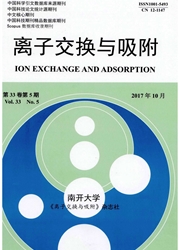

 中文摘要:
中文摘要:
将布洛芬通过静电和疏水作用的共同作用负载于聚苯乙烯型大孔弱碱性阴离子交换树脂D301R和D301T上,最佳负载条件为:布洛芬悬浮于5-10%的乙醇水溶液中,加入树脂后在60℃下搅拌12h,负载量可达到0.49g/g树脂。研究了负载的布洛芬在模拟胃肠道的条件下(pH2下2h、pH7.4下4h和pH6.7下18h)的释放动力学,在前12h的释放接近于线性释放,释放率为58~60%。后12h的释放量较小,释放率为13~17%。如果每12h服药1次,第2次服药后的24h的累加释放率接近于线性释放。与聚苯乙烯骨架的大孔弱碱性阴离子交换树脂相比,聚甲基丙烯酸酯骨架的弱碱性阴离子交换树脂(甲基丙烯酸正丁酯/甲基丙烯酸N,N-二甲胺基乙酯,双甲基丙烯酸乙二醇酯共聚物)负载的布洛芬在相同释放条件下突释明显,表明布洛芬与苯乙烯型弱碱性阴离子交换树脂之间的π-π作用在布洛芬的缓释中起关键的作用。
 英文摘要:
英文摘要:
Ibuprofen was loaded into polystyrene-based macroporous weakly basic anion exchange resins, D301R and D301T. The loading was driven by electrostatic and hydrophobic interactions. The optimized loading condition was: a suspension of the resin in 5-10% ethanol aqueous solution with dispersed ibuprofen was stirred for 12h at 60℃. The loading capacity could be up to 0.49gig resin. The release of the loaded ibuprofen in buffer mimicking gastrointestinal pH environments (2h, 4h and 18h at pH 2, 7.4 and 6.7, respectively) was studied. The loaded ibuprofen was released almost linearly against time in the first 12h with release percentage of 58-60%. The release percentage in the followed 12h was quite low, being 13-17%. In simulated administrations taken at 12h interval, the loaded ibuprofen in D301R was released almost linearly against time during a 24h period after the second administration. In contrast, an initial burst release of the loaded ibuprofen in a polymethacrylate-based weakly basic anion exchange resin [n-butyl methacrylate/(N,N-dimethylamino)ethyl methaerylate/ethylene glycol dimethacrylate copolymer] at neutral pH was observed. These results showed that n-n stacking interaction between ibuprofen and the carrier played a key role in the sustained release of ibuprofen from the polystyrene-based weakly basic anion exchange resins.
 同期刊论文项目
同期刊论文项目
 同项目期刊论文
同项目期刊论文
 期刊信息
期刊信息
